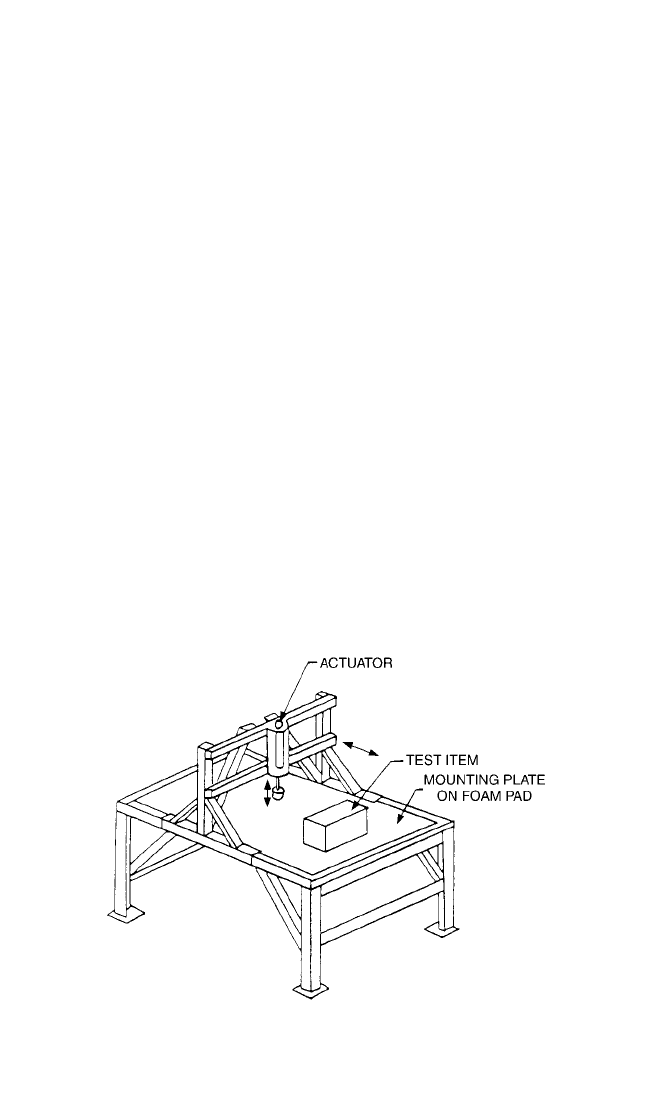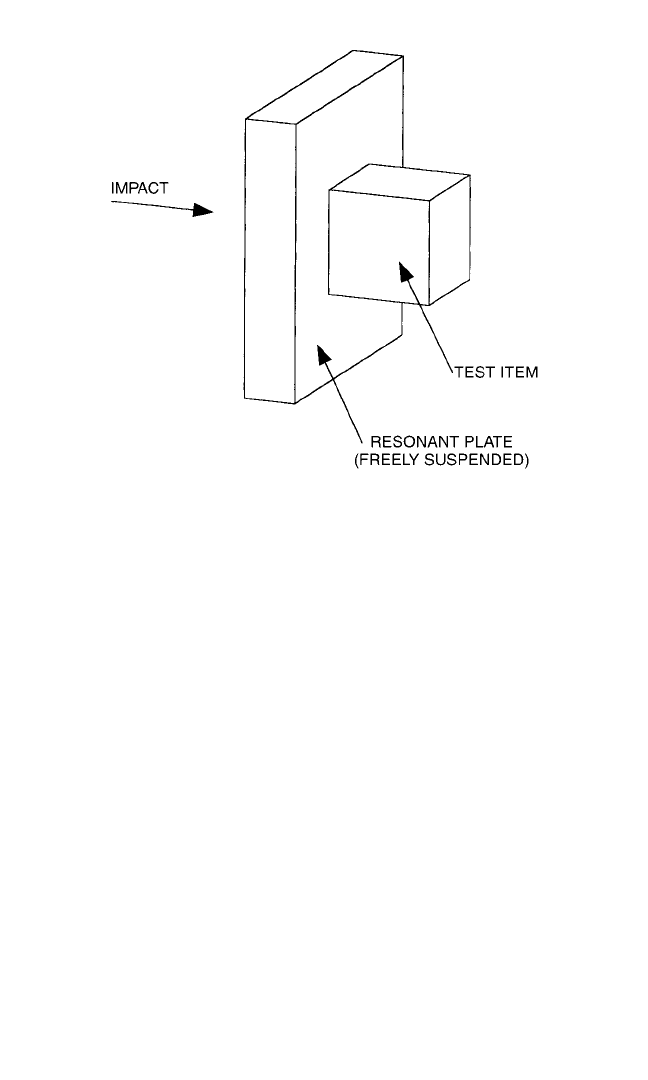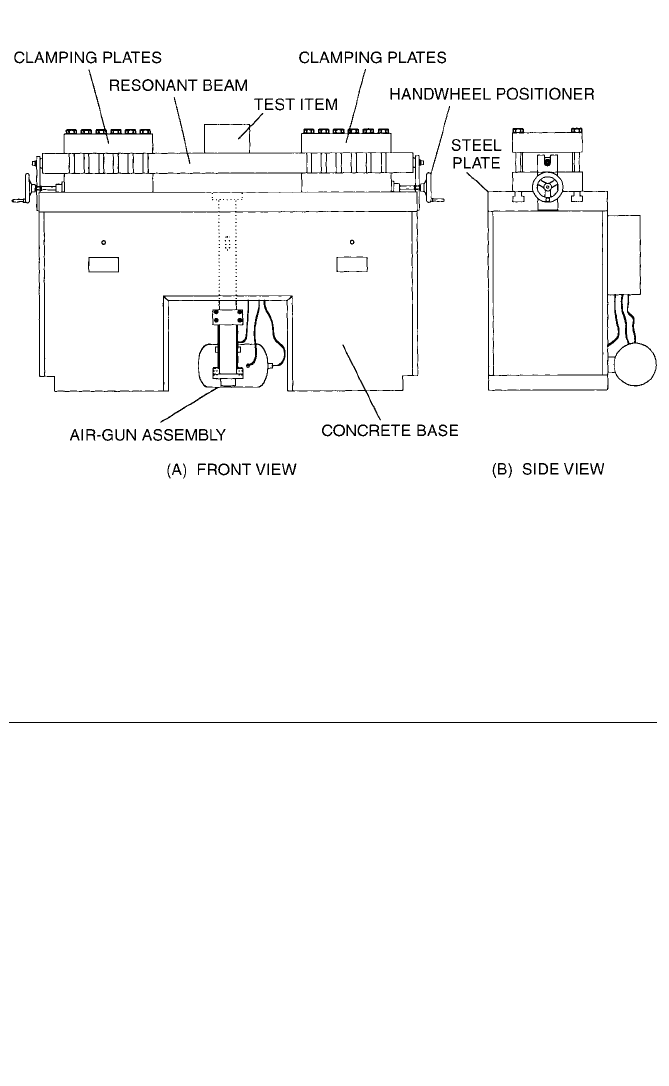Harris C.M., Piersol A.G. Harris Shock and vibration handbook
Подождите немного. Документ загружается.


and/or test specifications. This can be accomplished by using a simple resonant fix-
ture (usually a plate) instead of the complex structures described above. When such
a fixture is excited into resonance by a mechanical impact, its response can provide
an adequate pyroshock simulation to an attached test item. Excitation of the fixture
can be achieved as the result of the impact of a projectile, pendulum hammer, pneu-
matic piston, or the like on the fixture.The response of the fixture is dependent on a
large number of parameters including: (1) plate geometry and material, (2) impact
mass or speed, (3) impact duration, which is controlled with various impact materi-
als (e.g., metals, felt, elastomers, wood, etc.), (4) impact location, (5) test item loca-
tion, and (6) various clamps and plate suspension mechanisms. In theory these
parameters could be varied with the aid of an analytical model, but they are usually
evaluated experimentally. A significant effort is therefore required to obtain each
pyroshock simulation.
Mechanical Impulse Pyroshock (MIPS) Simulator. The MIPS simulator
20, 21
is
a well-developed embodiment of the trial-and-error resonant fixture methods. It is
universally referred to by its acronym and is widely used in the aerospace industry. Its
design facilitates the easy variation of many of the parameters described above. The
MIPS simulator configuration shown in Fig. 26.16 consists of an aluminum mounting
plate which rests on a thick foam pad. The shock is generated by a pneumatic actua-
tor which is rigidly attached to a movable bridge, facilitating various impact loca-
tions. The impactor head is interchangeable so that different materials (lead,
aluminum, steel, etc.) may be used to achieve variation of input duration. Although a
triaxial acceleration measurement is usually made at the control point near the test
item, it is unlikely that the test requirement will be met simultaneously in all axes.
Separate test configurations must normally be developed for each test axis. Once the
test configuration and procedures are determined, the results are very repeatable.
The configuration for a new test specification can be obtained more quickly if records
of previous setups and results are maintained for use as a starting point for the new
PYROSHOCK TESTING 26.27
FIGURE 26.16 MIPS simulator. The mounting plate is excited
into resonance by an impact from the actuator. The plate response
simulates far-field pyroshock for the attached test item. (Courtesy of
Martin Marrietta Astrospace.)
8434_Harris_26_b.qxd 09/20/2001 11:54 AM Page 26.27

specification. Reference 19 provides some general guidelines for parameter varia-
tion, as well as results obtained from several different test configurations.
Tuned Resonant Fixtures with Fixed Knee Frequency. It is possible to greatly
reduce the amount of trial and error required by the MIPS simulator and other res-
onant fixture test methods. In order to do this, a simple resonant fixture is designed
so that its dominant response frequency corresponds to the dominant frequency in
the shock response spectrum test requirement. These tuned resonant fixtures are
primarily limited to pyroshock environments which exhibit more or less typical
characteristics with knee frequencies up to 3000 Hz (or higher for small test items).
The basic design principle is to match the dominant fixture response frequency
(usually the first mode) to the shock response spectrum knee frequency. When this
fixture is excited into resonance, it will “automatically” have the desired shock
response spectrum knee frequency and the typical 9-dB/octave initial slope. This
concept was originally developed using a plate excited into its first bending mode
and a bar excited into its first longitudinal mode.
22
The methods described in the
following sections require relatively thick and massive resonant fixtures compared
to the structures to which the test item might be attached in actual use. Because of
this, the motion imparted to the test item attached to a resonant fixture is approxi-
mately in-phase from point-to-point across the mounting surface. Whereas, the
actual pyroshock motion may not be in-phase if the test item is mounted to a thin
structure in actual use. The in-phase motion of resonant fixtures yields some degree
of conservatism when selecting these methods for qualification testing. One signif-
icant advantage of using a thick resonant fixture is that its response is not greatly
influenced by the attached test item. This allows the same test apparatus to be used
for a variety of different test items.
Each of the tuned resonant fixture test methods described below produces a
simulated pyroshock environment with the same basic characteristics. These simi-
larities are illustrated in Fig. 26.17, which shows a typical acceleration record and
shock response spectrum from the tunable resonant beam apparatus described
later. The other methods produce pyroshock environments with initial shock
response spectra slopes that are slightly less than 9 dB/octave due to a small veloc-
ity change inherent with these other methods. The shock response spectrum shown
in Fig. 26.17 exhibits the desired typical shape, and the energy is concentrated at the
knee frequency. The absence of significant frequency content above the knee fre-
quency may cause the shock response spectrum to be too low at these frequencies.
In practice the attached test item adds some frequency content above the knee fre-
quency, which tends to increase the shock response spectrum. These test methods
allow good control and repeatability of the shock response spectrum, especially
below the knee frequency.
When using tuned resonant fixtures, the test item is usually attached to an inter-
mediate fixture such as a rectangular aluminum plate. This adapter fixture must be
small enough and stiff enough so that the input from the resonant fixture is not sig-
nificantly altered. Since the resonant fixture is designed to produce the pyroshock
simulation in only one direction, the adapter fixture should be designed so that it
may be rigidly attached to the resonant fixture in three orthogonal orientations (e.g.,
flat down and on each of two edges). The acceleration input should be measured
next to the test item on the adapter fixture. It is good practice to measure the accel-
eration in all three axes because it is possible (although infrequently) to simultane-
ously attain the desired test specification in more than one axis.
A number of different techniques are used to provide the mechanical impact
26.28 CHAPTER TWENTY-SIX, PART II
8434_Harris_26_b.qxd 09/20/2001 11:54 AM Page 26.28

required by the tuned resonant fixture methods described below. Pendulum hammers
of the general type shown in Fig. 26.8 have been used, as well as pneumatically driven
pistons or air guns. The method which is selected must provide repeatability and con-
trol of the impact force, both in magnitude and duration. The magnitude of the impact
force controls the overall test amplitude, and the impact duration must be appropriate
to excite the desired mode of the tuned resonant fixture. In general the impact dura-
tion should be about one-half the period of the desired mode. The magnitude of the
impact force is usually controlled by the impact speed, and the duration is controlled
by placing various materials (e.g., felt, cardboard, rubber, etc.) on the impact surfaces.
Resonant Plate (Bending Response). The resonant plate test method
23, 24
is
illustrated in Fig. 26.18, which shows a plate (usually a square or rectangular alu-
minum plate) freely suspended by some means such as bungee cords or ropes.A test
item is attached near the center of one face of the plate, which is excited into reso-
nance by a mechanical impact directed perpendicular to the center of the opposite
face. The resonant plate is designed so that its first bending mode corresponds to the
knee frequency of the test requirement.The first bending mode is approximately the
same as for a uniform beam with the same cross-section and length. Appendix 1.1
provides a convenient design tool for selecting the size of the resonant plate. The
plate must be large enough so that the test item does not extend beyond the middle
third of the plate. This assures that no part of the test item is attached at a nodal line
of the first bending mode. Usually, the resonant fixture with an attached test item is
insufficiently damped to yield the short-duration transient (5 to 20 milliseconds)
required for pyroshock simulation. Damping may be increased by adding various
attachments to the edge of the plate, such as C-clamps or metal bars. These attach-
ments may also lower the resonance frequency and must be accounted for when
designing a resonant plate.
PYROSHOCK TESTING 26.29
FIGURE 26.17 Typical shock response spectrum and acceleration time-
history from a tuned or tunable resonant fixture test. The shock response
spectrum is calculated from the inset acceleration time-history using a 5 per-
cent damping ratio.
8434_Harris_26_b.qxd 09/20/2001 11:54 AM Page 26.29

Resonant Bar (Longitudinal Response). The resonant bar concept
23,24
is illus-
trated in Fig. 26.19, which shows a freely suspended bar (typically aluminum or steel)
with rectangular cross section. A test item is attached at one end of the bar, which is
excited into resonance by a mechanical impact at the opposite end.The basic princi-
ple of the resonant bar test is exactly the same as for a resonant plate test except that
the first longitudinal mode of vibration of the bar is utilized.The bar length required
for a particular test can be calculated by
l = (26.4)
where l = length of the bar
c = wave speed in bar
f = first longitudinal mode of the bar (equal to desired knee frequency)
The other dimensions of the bar can be sized to accommodate the test item, but they
must be significantly less than the bar length.As with the resonant plate method, the
response of the bar can be damped with clamps if needed. These are most effective
if attached at the impact end.
Tunable Resonant Fixtures with Adjustable Knee Frequency. The tuned res-
onant fixture methods described above can produce typical pyroshock simulations
with knee frequencies that are fixed for each resonant fixture. A separate fixture
c
2f
26.30 CHAPTER TWENTY-SIX, PART II
FIGURE 26.18 Resonant plate test method. The first bending
mode is excited by an impact as shown. The plate’s response simu-
lates far-field pyroshock for the attached test item.The plate is sized
so that its first bending mode frequency corresponds to the desired
knee frequency of the test.
8434_Harris_26_b.qxd 09/20/2001 11:54 AM Page 26.30

must be designed and fabricated for each test requirement with a different knee fre-
quency, so that a potentially large inventory of resonant fixtures would be necessary
to cover a variety of test requirements. For this reason tunable resonant fixture test
methods were developed which allow an adjustable knee frequency for a single test
apparatus.
Tunable Resonant Bars. The frequency of the first longitudinal mode of vibra-
tion of the resonant bar shown in Fig. 26.19 can be tuned by attaching weights at
selected locations along the length of the bar.
24
If weights are attached at each of the
two nodes for the second mode of vibration of the bar, then the bar’s response will be
dominated by the second mode (2f). Similarly, if weights are attached at each of the
three nodes for the third mode of the bar, then the third mode (3f ) will dominate. It
is difficult to produce this effect for the fourth and higher modes of the bar since the
distance between nodes is too small to accommodate the weights. This technique
allows a single bar to be used to produce pyroshock simulations with one of three dif-
ferent knee frequencies. For example a 100-in. (2.54-m) aluminum bar can be used for
pyroshock simulations requiring a 1000-, or 2000-, or 3000-Hz knee frequency. If the
weights are attached slightly away from the node locations, the shock response spec-
trum tends to be “flatter” at frequencies above the knee frequency.
25
Another tunable resonant bar method
26
can be achieved by attaching weights
only to the impact end of the bar shown in Fig. 26.19. This method uses only the
first longitudinal mode, which can be lowered incrementally as more weights are
added. A nearly continuously adjustable knee frequency can thus be attained over
a finite frequency range.The upper limit of the knee frequency is the same as given
by Eq. (26.3) and is achieved with no added weights. In theory, this knee frequency
could be reduced in half if an infinite weight could be added. However, a realizable
lower limit of the knee frequency would be about 25 percent less than the upper
limit.
Tunable Resonant Beam. Figure 26.20 illustrates a tunable resonant beam
apparatus
26
which will produce typical pyroshock simulations with a knee frequency
that is adjustable over a wide frequency range. In this test method, an aluminum
beam with rectangular cross section is clamped to a massive base as shown. The
clamps are intended to impose nearly fixed-end conditions on the beam. When the
beam is struck with a cylindrical mass fired from the air-gun beneath the beam, it will
resonate at its first bending frequency, which is a function of the distance between
the clamps. Ideally, the portion of the beam between the clamps will respond as if it
had perfectly fixed ends and a length equal to the distance between the clamps. For
this ideal case, the frequency of the first mode of the beam varies inversely with the
square of the beam length. In practice, the end conditions are not perfectly fixed, and
the frequency of the first mode is somewhat lower than predicted.This method pro-
PYROSHOCK TESTING 26.31
FIGURE 26.19 Resonant bar test method. The first longitudinal bar mode is excited by
an impact as shown. The bar is sized so that its first normal mode frequency corresponds
to the desired knee frequency in the test.
8434_Harris_26_b.qxd 09/20/2001 11:54 AM Page 26.31

vides a good general-purpose pyroshock simulator, since the knee frequency is con-
tinuously adjustable over a wide frequency range (e.g., 500 to 3000 Hz). This tun-
ability allows small adjustments in the knee frequency to compensate for the effects
of test items of different weights.
REFERENCES
1. Valentekovich, V. M.: Proc. 64th Shock and Vibration Symposium, p. 92 (1993).
2. Moening, C. J.: Proc. 8th Aerospace Testing Seminar, p. 95 (1984).
3. Himelblau, H.,A. G. Piersol, J. H. Wise, and M. R. Grundvig: “Handbook for Dynamic Data
Acquisition and Analysis,” IES Recommended Practice 012.1, Institute of Environmental
Sciences, Mount Prospect, Ill. 60056.
4. Smallwood, D. O.: Shock and Vibration J., 1(6):507 (1994).
5. Baca, T. J.: Proc. 60th Shock and Vibration Symposium, p. 113 (1989).
6. Shinozuka, M.: J. of the Engineering of the Engineering Mechanics Division, Proc. of the
American Society of Civil Engineers, p. 727 (1970).
7. Smallwood, D. O.: Shock and Vibration Bulletin, 43:151 (1973).
8. Mark, W. D.: J. of Sound and Vibration, 22(3):249 (1972).
9. Bendat, J. S., and A. G. Piersol: “Engineering Applications of Correlation and Spectral
Analysis,” John Wiley & Sons, Inc., 2d ed., p. 325, 1993.
10. Bateman, V. I., R. G. Bell, III, and N. T. Davie: Proc. 60th Shock and Vibration Symposium,
1:273 (1989).
26.32 CHAPTER TWENTY-SIX, PART II
FIGURE 26.20 Tunable resonant beam test method. A beam, clamped near each end to a massive
concrete base, is excited into its first bending mode by an impact produced by the air-gun.
8434_Harris_26_b.qxd 09/20/2001 11:54 AM Page 26.32

11. Bateman, V. I., R. G. Bell, III, F. A. Brown, N. T. Davie, and M. A. Nusser: Proc. 61st Shock
and Vibration Symposium, IV:161 (1990).
12. Valentekovich, V. M., M. Navid, and A. C. Goding: Proc. 60th Shock and Vibration Sympo-
sium, 1:259 (1989).
13. Valentekovich, V. M., and A. C. Goding: Proc. 61st Shock and Vibration Symposium, 2 (1990).
14. Czajkowski, J., P. Lieberman, and J. Rehard: J. of the Institute of Environmental Sciences,
35(6):25 (1992).
15. Fandrich, R. T.: Proc. Institute of Environmental Sciences Annual Technical Meeting,
p. 269 (1974).
16. Luhrs, H. N.: Proc. Institute of Environmental Sciences Annual Technical Meeting, p. 17
(1981).
17. Powers, D. R.: Shock and Vibration Bulletin, 56(3):133 (1986).
18. Bateman, V. I., and F.A. Brown: J. of the Institute of Environmental Sciences, 37(5):40 (1994).
19. Bateman, V. I., F. A. Brown, J. S. Cap, and M. A. Nusser: Proceedings of the 70th Shock and
Vibration Symposium,Vol. I (1999).
20. Dwyer,T. J., and D. S. Moul: 15th Space Simulation Conference, Goddard Space Flight Cen-
ter, NASA-CP-3015, p. 125 (1988).
21. Raichel, D. R., Jet Propulsion Lab, California Institute of Technology, Pasadena (1991).
22. Bai, M., and W. Thatcher: Shock and Vibration Bulletin, 49(1):97 (1979).
23. Davie, N. T.: Shock and Vibration Bulletin, 56(3):109 (1986).
24. Davie, N. T., Proc. Institute of Environmental Sciences Annual Technical Meeting, p. 344
(1985).
25. Shannon, K. L., and T. L. Gentry:“Shock Testing Apparatus,” U. S. Patent No. 5,003,810, 1991.
26. Davie, N. T., and V. I. Bateman: Proc. Institute of Environmental Sciences Annual Technical
Meeting, p. 504 (1994).
PYROSHOCK TESTING 26.33
8434_Harris_26_b.qxd 09/20/2001 11:54 AM Page 26.33

CHAPTER 27
APPLICATION OF
DIGITAL COMPUTERS
Marcos A. Underwood
INTRODUCTION
This chapter introduces numerous applications and tools that are available on and
with digital computers for the solution of shock and vibration problems. First, the
types of computers that are used, the associated specialized processors, and their
input and output peripherals, are considered.This is followed by a discussion of com-
puter applications that fall into the following basic categories: (1) numerical analy-
ses of dynamic systems, (2) experimental applications that require the synthesis of
excitation (driving) signals for electrodynamic and electrohydraulic exciters (shak-
ers), and (3) the acquisition of the associated responses and the digital processing of
these responses to determine important structural characteristics.
The decision to employ a digital computer–based system for the solution of a
shock or vibration problem should be made with considerable care. Before particu-
lar computer software or hardware is selected, the following matters should be care-
fully considered.
1. The existing hardware and/or software that is or is not available to perform the
required task.
2. The extent to which the task or the existing software/hardware must be modified
in order to perform the task.
3. If no applicable software/hardware exists, the extent of the development effort
necessary to create the suitable software and/or hardware subsystems.
4. The detailed assumptions needed in the software/hardware in order to simplify
its development (e.g., linearity, proportional damping, frequency content, sam-
pling rates, etc.).
5. The ability of the software/hardware to measure and compute the output infor-
mation required (e.g., absolute vs. relative motion, phase relationships, rotational
information, etc.).
27.1
8434_Harris_27_b.qxd 09/20/2001 11:51 AM Page 27.1

6. The detailed input and output limitations of the needed system software and/or
hardware (types of excitation signals, voltage ranges, minimum detectable signal
amplitudes, calculation rates, control speed, graphic outputs, setup parameters,
etc.).
7. The processing power and time needed to perform the task.
8. The algorithms and hardware features that are needed to perform the task.
After these matters are resolved, the user must realize that the results obtained
from the output of a computer system can be no better than its available inputs. For
example, the quality of the natural frequencies and mode shapes obtained from a
structural analysis software system depends heavily on the degree to which the
mathematical model employed represents the actual mass, stiffness, and damping of
the physical structure being analyzed (see Chap. 21). Likewise, a spectral analysis of
a signal with poor signal-to-noise ratio will provide an accurate spectrum of the sig-
nal plus the measurement noise, but not of the signal amplitudes that fall below the
noise floor (see Chap. 22).
DIGITAL COMPUTER TYPES
The digital computer types that are used to solve shock and vibration problems are
varied. There are general-purpose or specialized digital computers. It is generally
better to use general-purpose computers whenever possible, since these types of dig-
ital computers are supported with the best graphics, applications development, sci-
entific and engineering tools, and the wider availability of preexisting applications
software. However, even within these general categories, there are various processor
or computer configurations available to help solve shock and vibration problems.
The following sections provide definitions, descriptions, and discussions of the appli-
cability of general-purpose computers and specialized processors that can help solve
shock and vibration problems.
GENERAL PURPOSE
General-purpose computers are computers designed to solve a wide range of prob-
lems. They are optimized to allow many individual users to access the particular
computer system’s resources. They range from large central systems like main-
frames, which can handle thousands of simultaneous users, to personal computers,
which are designed to serve one interactive user at a time and provide direct and
easy access to the computer system’s computational capability through thousands of
existing applications and its graphical user interface. These are personified by per-
sonal computers based on Wintel (i.e., Windows and Intel) or Power PC technolo-
gies. In the following, mainframes, workstations, personal computers, and palmtop
digital computers are discussed from the viewpoint of their applicability to solve
shock and vibration problems.
Mainframes. Mainframe computers are computer systems that are optimized to
serve many users simultaneously. They typically have large memories, many parallel
central processing units, large-capacity disk storage, and high-bandwidth local net-
work and Internet connections.These systems, when available, can be used to solve the
largest shock and vibration simulations, where very large finite element models or
27.2 CHAPTER TWENTY-SEVEN
8434_Harris_27_b.qxd 09/20/2001 11:51 AM Page 27.2

other discrete system models require large memories and the processing power that
mainframes provide. They are also used for web or disk server functions to networked
workstations and personal computers. Mainframe computers are increasingly being
replaced by either powerful workstation or personal computer–based systems.
Workstations. Workstations are computer systems that provide dedicated com-
puter processing for individual users that typically are involved in technically spe-
cialized and complex computing activities. These computer systems usually run a
version of the UNIX operating system using a graphical user interface that is based
on X-windows; X-windows is a set of libraries of graphical software routines, devel-
oped by an industry consortium that provide a standard access to the workstation’s
graphics hardware through a graphical user interface. Workstations often are based
on reduced instruction set computer systems, to be discussed in a later section, with
significant floating point processing power, sophisticated graphic hardware systems,
and access to large disk and random access memory systems. This suits them for
computer-assisted engineering activities like large-scale simulations, mechanical and
electrical system design and drafting, significant applications in the experimental
area that involve many channels of data acquisition and analysis, and the control of
multiexciter vibration test systems. They are designed to efficiently serve one user,
but are inherently multiuser, multitasking, and multiprocessor in nature, and can
serve as a suitable replacement for mainframes in the server arena. These systems
are now mature, with capability still expanding, but merging in the future with high-
powered personal computers. However, due to their maturity, they have an inherent
reliability advantage over personal computers, and thus have a higher suitability for
mission-critical applications. Newer versions of UNIX, like LINUX, allow personal
computer hardware to be used as a workstation, affording the power and reliability
of workstations with the convenience of personal computer hardware.
Personal Computers. Personal computers (PCs) are computer systems that are
intended to be used by casual users and are designed for simplicity of use. PCs orig-
inally were targeted to be used as home- and hobby-oriented computers. Over the
years, PCs have evolved into systems that have central processing units that rival
those of workstations and some older mainframes. PC operating systems have also
evolved to provide access to large disk and random access memories, and a sophisti-
cated graphical user interface. They have many applications in the shock and vibra-
tion arena that are available commercially. These applications include sophisticated
word processors, spreadsheet processors, graphics processors, system modeling tools
like Matlab, design applications, and countless other computer-aided engineering
applications.
There are also many experimental applications like modal analysis, signal analy-
sis, and vibration control systems that are implemented using PCs. These types of
systems are typically less expensive when they are built using PCs rather than work-
stations. At this time, however, workstations still provide greater performance and
reliability than PCs. PC operating systems are not as robust as those that run on
workstations, although this may change in the future. PCs, however, are ubiquitous
and the hardware and software used to make them continues to expand in capabil-
ity and reliability. It is likely that the PC and workstation categories will ultimately
merge, hopefully preserving the best of both worlds. Currently, most PCs are based
on Wintel technologies, with a smaller percentage based on Power PC technologies.
Palmtops. Palmtop computers (also called hand-held computers) are computer
systems that are designed for extreme portability and moderate computing applica-
APPLICATION OF DIGITAL COMPUTERS 27.3
8434_Harris_27_b.qxd 09/20/2001 11:51 AM Page 27.3
